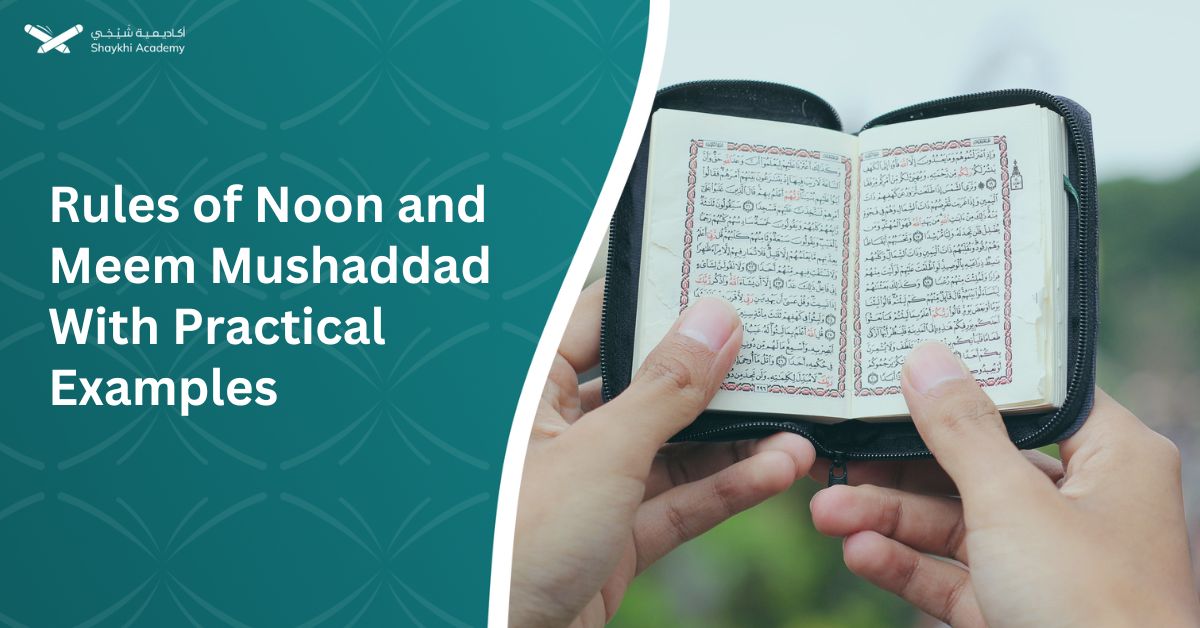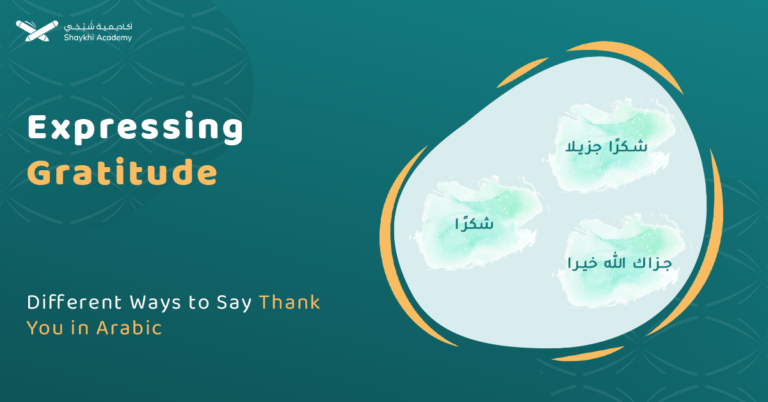In Tajweed, Noon and Meem Mushaddad are critical rules marked by a shaddah (ّ), which indicates the doubling of these letters with a nasal sound (ghunnah) lasting two counts. For Noon Mushaddad, such as in “إنّ” (Inna), and Meem Mushaddad, like in “أمّ” (Umma), the rule involves merging the silent letter into the moving letter, resulting in an intensified pronunciation essential for proper Quranic recitation.
The Meem and the noon mushaddad are the most widespread rules of tajweed in the Holy Quran, therefore learning them is very important for correct recitation. Through this article, we will help you get to know them and we will explain to you their rules in a simplified way… Let’s go!
What do Shaddah and Mushaddad mean?
Before anything else, let’s understand together the concept of “shadda” and what “mushaddad” means.
Shaddah is a diacritic mark in the Arabic language that is placed above a letter to indicate that this letter is stressed, doubled, or repeated. The symbol for shaddah is (ّ).
Mushaddad is the Arabic term that translates to “strengthened,” “intensified,” or “reinforced.” In the context of Arabic grammar, it often refers to words or forms that have been intensified or emphasized.
For instance, in Arabic, a verb can be intensified by doubling one of its root letters, which is called “tashdid” (تشديد). The resulting verb is called “mushaddad” (مشدّد).
Mushaddad Meaning in English
Mushaddad in English has the same meaning as the adjectives strengthened, corroborated, and doubled.
It is the letter represented by the diacritical mark tashdeed (ّ ) over it.
What is a Mushaddad Letter?
A “mushaddad” letter is a doubled or repeated letter, indicated in writing by placing a shadda (ّ) above the letter. This means that the letter is pronounced as if it were two letters, the first being silent and the second being pronounced.
For example:
The word “مَدَّ” (mad-da) contains a “mushaddad” letter “د,” pronounced as if it were “مدْدَ,” with the first “د” being saakin followed by a pronounced “د.”
What do Noon and Meem Mushaddad mean?
The Noon and Meem Mushaddad are the most widespread rules of Tajweed. Noon Mushaddad and Meem Mushaddad, marked by a shaddah, indicate doubled pronunciation of the letters “ن” and “م” respectively, crucial for proper Tajweed and meaning in Quranic recitation. For example, “إنّ” emphasizes the “n” sound, and “أمّ” emphasizes the “m” sound.
1. Noon Mushaddad (نُون مُشَدَّدَة)
Noon Mushaddad” (نُون مُشَدَّدَة) refers to the letter “ن” (noon) with a shaddah (ّ) mark. The shaddah indicates that the letter is doubled, or pronounced with greater emphasis.
Essentially, it means the “noon” is pronounced twice in quick succession.
For example, the word “إنّ” contains a Noon Mushaddad, and it is pronounced with an emphasis on the “n” sound like “inn”.
2. Meem Mushaddad (مِيم مُشَدَّدَة)
“Meem Mushaddad” (مِيم مُشَدَّدَة) refers to the letter “م” (Meem) with a shaddah mark. This also indicates that the letter “Meem” is doubled or pronounced with emphasis.
For example, the word “أمّ” contains a Meem Mushaddad, and it is pronounced with an emphasis on the “m” sound like (umm).
The shaddah mark in Arabic grammar is crucial for proper pronunciation and meaning of words, as it can change both.
Noon Mushaddad examples
To clearly identify the Noon Mushaddad, here are some examples from the Quran.
The Almighty saying in:
Surah Al-Kawthar, verse 1:
“Indeed, we have given you Al-Kawthar”
“إِنَّا أَعْطَيْنَاكَ الْكَوْثَرَ”
The noon mushaddad in the word (إِنَّا)
Surah Yusuf, verse 4:
“When Joseph said to his father, ‘O my father, I saw eleven stars’
“إِذْ قَالَ يُوسُفُ لِأَبِيهِ يَا أَبَتِ إِنِّي رَأَيْتُ أَحَدَ عَشَرَ كَوْكَبًا”
The noon mushaddad in the word (إِنِّي)
Surah Al-Qadr, verse 1:
“Indeed, we sent it down on the Night of Decree”
“إِنَّا أَنْزَلْنَاهُ فِي لَيْلَةِ الْقَدْرِ”
The noon mushaddad in the word (إِنَّا)
Meem mushaddad examples
To clearly identify the Noon Mushaddad, here are some examples from the Quran.
The Almighty saying in:
Surat Al-Baqarah verse 286
Our Lord, do not burden us with what we have no strength to bear.
رَبَّنَا وَلَا تُحَمِّلْنَا مَا لَا طَاقَةَ لَنَا بِهِ ۖ
The meem mushaddad in the word (تُحَمِّلْنَا)
Surah Al-Masad, verse 4
And his wife was the firewood carrier.
وَٱمۡرَأَتُهُۥ حَمَّالَةَ ٱلۡحَطَبِ
The meem mushaddad in the word (حَمَّالَةَ)
Surah Al-Naba’ verse 1
What are they wondering?
عَمَّ يَتَسَآءَلُونَ
The meem mushaddad in the word (عَمَّ)
What are the Rules of Noon and Meem Mushaddad
The rule for Noon and Meem Mushaddad in Tajweed is simple: whenever you see a shaddah on a meem or noon, pronounce it with a ghunnah (nasal sound) lasting two counts (2 haraka). This involves merging the saakin letter into the moving letter, resulting in an intensified pronunciation with a nasal sound.
1. Meem Mushaddad (مّ) examples
أَمَّا: Written as “أَمْ + مَا” (Amma).
إِمَّا: Written as “إِمْ + مَا” (Imma).
Idgham (Merging) is the rule for Meem Mushaddad: The saakin Meem is merged into the moving Meem, resulting in a single intensified Meem pronounced with a ghunnah.
2. Noon Mushaddad (نّ) Examples
إِنَّ: Written as “إِنْ + نَ” (Inna).
مَنَّ: Written as “مَنْ + نَ” (Manna).
As a beginner learner of Tajweed rules, you might sometimes confuse the terminology, such as mixing up Meem Sakinah and Meem Mushaddad, or Noon Mushaddad and Noon Sakinah and tanween. Therefore, we will briefly distinguish between them to help you understand them better.
Comparison Between Meem Sakinah And Meem Mushaddad:
The rules for Meem Sakinah (مْ) and Meem Mushaddad (مّ) differ in terms of pronunciation and application. Here is a comparison:
1. Meem Sakinah (مْ)
Meem Sakinah refers to the Meem with a Sukoon (ْ), meaning it is silent.
The rules for Meem Sakinah are as follows:
A. Ikhfa Shafawi (شفوي):
Occurs when Meem Sakinah is followed by the letter “ب” (Baa). In this rule the Meem Sakinah is pronounced with a slight nasal sound (ghunnah),
For example:
In Surah Al-Fil verse 4:
“ترمْيهم بحجارة”
B. Idgham Shafawi (ادغام شفوي):
Occurs when Meem Sakinah is followed by another Meem.
In this case the first Meem is merged into the second Meem, resulting in a single Meem Mushaddad pronounced with a nasal sound (ghunnah).
For example:
In Surah Al-Baqarah verse 218
“لهم مغفرة”
C. Izhar Shafawi (اظهار شفوي):
Occurs when Meem Sakinah is followed by any letter other than “ب” (Baa) or Meem.
The Meem Sakinah is pronounced clearly without a ghunnah.
For example:
Surah Al-Fatiha verse 7
“أنعمْت عليهم”
2. Meem Mushaddad (مّ)
Meem Mushaddad refers to the Meem that has a Shaddah ( ّ), indicating that it is pronounced as a single, intensified letter.
The rules for Meem Mushaddad are simpler compared to Meem Sakinah:
The Meem Mushaddad is always pronounced with a nasal sound (ghunnah) lasting for two counts.
For example: Surah Ad-Duha verse 9
“أَمَّا”
Compare that with The Rules of Noon Sakinah and Tanween:
As we mentioned above, noon mushaddad is always pronounced with a nasal sound (ghunnah) lasting for two counts.
On the Other hand Noon sakinah is a noon with a Sukoon symbol (ْ), and tanween is a double vocalization that occurs at the end of syllables and has the same sound as the noon saakin.
Its pronunciation changes based on the following letter and follows specific rules:
1. Idgham
Idgham means “merging” and it is applied if noon Sakinah or Tanween followed by one of the six Idgham letters (ي – ر – م – ل – و – ن), the Noon sound merges with the following letter. Idgham can be with or without ghunnah.
2. Izhar
This rule is applied if one of the six throat letters (أ – هـ -ع – ح – غ – خ) comes after the noun Sakinah or Tanween. It is clearly pronounced without ghunnah.
For example, God Almighty says in verse 4 of Surat Al-Talaq:
وَمَن يَتَّقِ اللَّهَ يَجْعَل لَّهُ مِنْ أَمْرِهِ يُسْرًا
And God almighty saying in Surat Muhammad, verse 15:
فِيها أَنْهارٌ مِنْ ماءٍ غَيْرِ آسِنٍ
3. Iqlab
Iqlab means “conversion.” We apply this rule when noon Sakinah or tanween is followed by the letter ب (Ba), the Noon sound is converted into a Meem sound with ghunnah.
For example, God Almighty said in Surah Fussilat, verse 5:
وَمِن بَيْنِنَا وَبَيْنِكَ حِجَابٌ
4. Ikhfa
All letters of the Arabic alphabet, except for the letters we mentioned in the rules of Izhar, Iqlab, and Idgham, are called letters of Ikhfa. It is fifteen letters which are (ص، ذ، ث، ك، ج، ش، ق، س، د، ط، ز، ف، ت، ض، ظ). In this rule, the Tanween or Noon Sakinah is hidden if one of these letters is used after the tanween or noon sakinah.
When concealing the saakin noon or tanween must be taken to extend the ghunnah by the amount of two vowels, and to make it amplified if the letter of ikhfaa is amplified, such as:
إِنَّهُ كَانَ مَنْصُوراً
(Al-Isra 33).
Unlock the Path to Quranic Mastery with Shaykhi Academy!
Are you seeking the finest Quranic education right from the comfort of your home? Look no further! Shaykhi Academy stands out as a premier online Quran learning platform, dedicated to providing exemplary education to both children and adults.
Why Choose Shaykhi Academy?
- Connect with highly qualified native tutors.
- Flexible scheduling to suit your busy lifestyle.
- Affordable classes tailored for all levels.
- Accessible from anywhere around the globe.
Discover Our Range of Courses:
- Arabic Noorani Qaida: Lay a solid foundation for Quranic studies.
- Online Quran Classes for Kids: Engaging lessons for lifelong learning.
- Tajweed Rules for Kids: Learn to recite with confidence.
- Quran Hifz for Kids: Step-by-step guidance to memorize the Quran.
- Quran for Adults: Introduce yourself to Quran reading and Tajweed rules.
- Online Arabic Courses: Master the language of the Quran.
- Islamic Studies: A wide range of topics related to Islam, including theology, law, Quranic studies, Hadith.
Don’t Miss Out on Your Chance to Excel!Whether you’re a beginner or seeking advanced knowledge, Shaykhi Academy can guide you! Book your free trial now

Conclusion
The rules of Noon and Meem Mushaddad are essential for proper Quranic recitation. “Mushaddad” means “strengthened” and refers to letters with a shaddah (ّ) mark, indicating doubled pronunciation. Noon Mushaddad (نّ) and Meem Mushaddad (مّ) are pronounced with a nasal sound (ghunnah) lasting two counts, ensuring correct emphasis and clarity in recitation.
Understanding and applying these rules is vital as they are the most common in Tajweed. For example, in “إنّ” (Inna) and “أمّ” (Umma), the shaddah on Noon and Meem signifies intensified pronunciation, enhancing the proper recitation of the Quran. This involves merging the saakin letter into the moving letter, resulting in a single intensified sound with a nasal quality.


















































